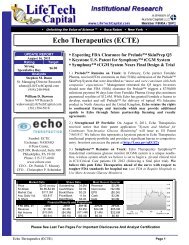NovaBay Pharmaceuticals (NBY) - LifeTech Capital
NovaBay Pharmaceuticals (NBY) - LifeTech Capital
NovaBay Pharmaceuticals (NBY) - LifeTech Capital
You also want an ePaper? Increase the reach of your titles
YUMPU automatically turns print PDFs into web optimized ePapers that Google loves.
www.<strong>LifeTech</strong><strong>Capital</strong>.com December 7, 2010<br />
� Currently, there is no bladder irrigation solution that can reduce or eliminate CAUTI.<br />
Catheter-associated urinary tract infections are caused by a variety of pathogens, including Proteus mirabilis, Escherichia<br />
coli, Klebsiella, Proteus, Enterococcus, Pseudomonas, Enterobacter, Serratia, and Candida with reported infection rates<br />
from 1%-5% after a single brief catheterization to virtually 100% of patients with indwelling urethral catheters draining<br />
into an open system longer than 4 days. For patients who require indwelling urethral catheterization, adherence to the<br />
sterile continuously closed system of urinary drainage is the current standard of care. For short-term catheterization, this<br />
may reduce the rate of infection from 100% when open drainage is employed to less than 25%, which is still an extremely<br />
high rate of infection. It should be noted that bacterial Biofilm is visible by the second day.<br />
Investors should note that on April 13, 2010 the 2009 U.S. HHS Agency for Healthcare Research and Quality report<br />
indicates that postoperative Catheter-Associated Urinary Tract Infections increased by 3.6% according to the Centers for<br />
Medicare and Medicaid Services (CMS) tracking data.<br />
The Summary can be found at: http://www.ahrq.gov/news/press/pr2010/qrdr09pr.htm<br />
And the Full Report is available for download at: http://www.ahrq.gov/qual/nhqr09/nhqr09.pdf<br />
Planned Phase IIb Clinical Trial for Catheter Encrustation and Blockage<br />
On April 19, 2010, <strong>NovaBay</strong> announced their intention to begin a Phase II clinical trial in urinary catheter encrustation<br />
and blockage. Some of the details of the planned trial are that a 0.2% concentration of NVC-422 in a new formulation will<br />
be used versus a saline control arm in quadriplegic spinal cord injury patients. The trial endpoints will measure Time to<br />
Catheter Blockage and Degree of Encrustation. The trial is expected to initiate Q4 2010 with data in Q4 2011.<br />
Approximately 700,000 patients suffer from chronic medical conditions requiring long-term urinary tract catheter use<br />
such as spinal cord injuries, stroke, spina bifida and multiple sclerosis. According to the University of Alabama National<br />
Spinal Cord Injury Statistical Center, there are approximately 250,000 spinal cord injury patients in the U.S. with<br />
approximately 44% being paraplegics (or approximately 110,000 patients). These patients suffer from chronic catheter<br />
encrustation and blockages, which we expect to be <strong>NovaBay</strong>’s initial market. We are assuming these patient’s catheters<br />
are maintained 3.5 times per week (every other day) resulting in approximately 18.2M total treatments per year (100,000 x<br />
3.5x/week x 52 weeks). For this difficult high-risk patient population, we believe the price per treatment will be<br />
approximately $12 per treatment representing a 3x increase over the current $4 per treatment cost of triclosan and saline<br />
and yielding sales of approximately $200M per year. We also believe that it may then be adopted for use as a prophylactic<br />
in the remaining patient population, however we have not yet included this in our financial model. For more information<br />
see the National Spinal Cord Injury Statistical Center at https://www.nscisc.uab.edu<br />
On March 25, 2010 we interviewed Dr. David Stickler of Cardiff University, a Key Opinion Leader on Biofilms and<br />
Catheter-Associated Urinary Tract Infections (CAUTI) with a focus on catheter encrustation and blockage in permanently<br />
catheterized patients. In the interview, he discusses patient populations, biofilms and CAUTI, prevention and treatment for<br />
catheter encrustation and blockage as well as his opinions on <strong>NovaBay</strong> <strong>Pharmaceuticals</strong> Aganocide® program for<br />
CAUTI. Investors can listen to the interview at http://www.lifetechcapital.com/novabay.htm<br />
Results of Phase IIa Proof of Concept Clinical Trial<br />
On April 15, 2010 <strong>NovaBay</strong> announced positive results of the open-label Phase IIa trial of NVC-422 in chronically<br />
catheterized patients with significant bacteriuria, or bacteria in the urine. The study showed that NVC-422 was well<br />
tolerated and reduced or eliminated certain pathogens in the urine.<br />
Enrollment: included a condition requiring chronic transurethral catheterization for at least one month prior to<br />
enrollment, documented high levels of bacteriuria, and no treatment with antimicrobial agents during the preceding week.<br />
Methods: Following baseline urine cultures, 25 to 100mL of a sterile solution of NVC-422, depending on bladder<br />
capacity, was instilled through the catheter into the bladder. The drainage tube was clamped for 1 hour and then allowed<br />
to drain. Urine specimens were collected before and following each instillation and daily during post-treatment follow-up.<br />
� Part 1: 5 patients were treated with a single administration of 0.1% NVC-422.<br />
<strong>NovaBay</strong> <strong>Pharmaceuticals</strong> (<strong>NBY</strong>) Page 9



